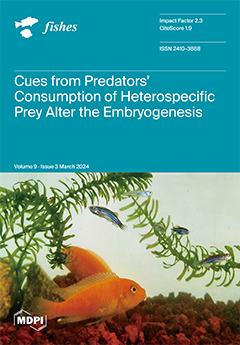The research aimed to analyze the influences of adding marine green algae
Chaetomorpha aerea to the diet of guppy fish (
Poecillia reticulate) on growth, immunological responses in skin mucus, total carotenoid content, and sexual characteristics. A total of 450 fish, with
[...] Read more.
The research aimed to analyze the influences of adding marine green algae
Chaetomorpha aerea to the diet of guppy fish (
Poecillia reticulate) on growth, immunological responses in skin mucus, total carotenoid content, and sexual characteristics. A total of 450 fish, with a mean body weight of 0.19 ± 0.1 g and 30 fish per tank (triplicate), were randomly fed into 15 experimental tanks, each containing 50 L. Five different diets with 0, 1, 2, 4, 8, and 10% of
C. aerea g/kg diets were fed to
P. reticulate for 30 days. After 30 days, growth, immunological responses in skin mucus, total carotenoid content, and sexual characteristics were investigated. The results observed that the feed conversion rate and fry output were significantly (
p > 0.05) decreased in experimental groups compared to the control group. The results revealed that the dietary inclusion of
C. aerea algal significantly increased (
p < 0.05) in mucosal immunological parameters containing lysozyme activity, myeloperoxidase activity, total immunoglobulins, and alternative complement activity, which were the highest in the group with 4% of
C. aerea g/kg. Additionally, lateral skin and the caudal fin of fish had higher total carotenoid levels from the dietary
C. aerea algae diet than the control group, which were the highest in the groups with 4%. Among them, 4 and 8% of
C. aerea g/kg diet resulted in better growth performance and feed conversion ratio. Thus, the study suggested that 4% of
C. aerea g/kg diet has enrichment of immunity, total carotenoid concentrations, and skin mucus immunity of
P. reticulate.
Full article





